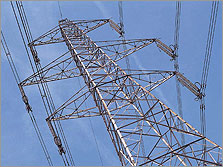NEW YORK (CNNMoney.com) -- For a long time, conventional wisdom has held that coal would easily meet the nation's rising demand for electricity. It's cheap, and there's enough of it in the U.S. to power the country for an estimated 250 years.
But a combination of rising construction costs for coal-fired power-plants and uncertainty over whether Congress will regulate emissions of carbon dioxide - a byproduct of burning coal and one of the main gasses behind global warming - has put plans for many new plants on hold.
 |
| Rising construction costs and uncertainty over global warming laws may lead to higher power prices for everyone, experts say. |
With the nation's demand for power expected to surge 50 percent over the next 30 years, the result may be higher electricity costs for everyone.
An estimated one-third of planned new coal plants have either been delayed or are "at the edge of cancellation," said Dean Oskvig, head of the energy business at Black&Veatch, an engineering firm that builds power plants.
Oskvig said cost is the main concern. The global commodities boom has caused the price of steel, concrete and lumber to soar. Plus, a spike in demand for energy of all kinds has led to a construction frenzy throughout the sector, driving up the cost of skilled labor.
This has doubled the price of building a new coal-fired power plant, said Judah Rose, an industry expert at ICF Consulting, who testified before the North Carolina Utilities Commission.
Nuclear and natural gas plants -- which together with coal provide about 90 percent of the nation's power -- are also affected by rising construction costs.
But natural gas plants are cheaper to build that coal plants, which can often top $2 billion a piece.
The cheaper construction cost is one reason utilities may be tempted to go with natural gas.
But another reason is uncertainty over what Congress will do to regulate greenhouse gasses.
There are several proposals in both chambers that would force mandatory reductions of carbon dioxide at the federal level (there is currently no federal policy on carbon dioxide). Debate on the issue is expected to begin this fall.
Given that the regulatory environment is largely unknown, utilities are likely to put off committing billions of dollars to a new coal project until a law is passed.
"The country will be underinvested in base-load coal capacity so long as there is government uncertainty," said William Durbin, head of global gas and power research at the energy consultantcy Wood Mackenzie.
Utilities, Durbin said, will instead invest in natural gas plants, which are cleaner burning than coal plants and less likely to run afoul of any carbon regulations.
But natural gas prices are much more volatile than coal, and are often considerably higher.
"That will translate into higher consumer power prices," said Durbin.
Exactly how much higher is hard to say, but he said it could be 15 to 20 percent.
The longer Congress waits to make clear carbon rules, the longer utilities will remain in limbo.
"If no policy gets crafted, that will be the most costly," said Pete Altman, coal campaign director at the National Environmental Trust.
Carbon laws or not, American Electric Power, a big Midwestern utility said to be the largest user of coal in the U.S., is pushing ahead to build four new coal plants.
The company plans on spending over $7 billion on the plants, the last of which is slated to come on line by 2017, according to company spokesperson Melissa McHenry.
Two of these plants are "supercritical" -- meaning the coal is burned more efficiently at a higher temperature -- possibly with an eye toward future carbon regulations.
The other two plants will gasify the coal before burning it, which is another, cleaner coal-burning approach.
But these cleaner technologies also make the plants more expensive. McHenry said the gasification plants cost 20 percent more than a normal plant.
She added that the company plans on using technology to capture the carbon and bury it underground, when that becomes feasible. That technique, known as carbon sequestration, is still in the early stages of development.
Black & Veatch's Oskvig said carbon capture and sequestration can raise the price of a power plant by 40 to 80 percent -- yet another factor that will drive power prices higher.
"We've been used to really cheap energy to drive our society," he said. "But the days of the energy bargain in this world are over." 